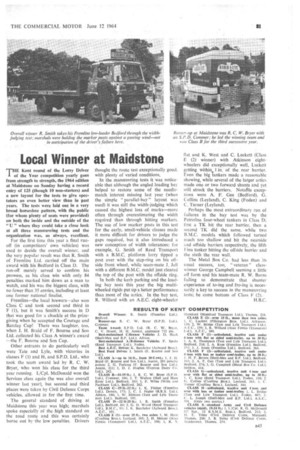Local Winner at• Maidstone
Page 83

If you've noticed an error in this article please click here to report it so we can fix it.
THE Kent round of the Lorry Driver L of the Year competition yearly goes from strength to strength, the 1964 edition at Maidstone on Sunday having a record entry of 125 (though 10 non-starters) and a new layout for the tests to give spectators an even better view than in past years. The tests were laid out in a very broad horseshoe pattern, with the public (for whom plenty of seats were provided) on both the inside and the outside of the "U" where they could take a close look at all three manoeuvring tests and the organization was, as always, excellent.
For the first time this year a final runoff (in competitors' own vehicles) was used to decide the overall winner, and the very popular result was that R. Smith of Fremlins Ltd. carried off the main award with his Bedford in Class D. The run-off merely served to confirm his prowess, as his class win with only 84 penalties marked him down as a man to watch, and his was the biggest class, with no fewer than 35 entries, including at least one former national finalist.
Fremlins—the local brewers—also won Class C and took second and third in F (1),, but it was Smith's success in D that was good for a chuckle at the prizegiving when he accepted the Courage and Barclay Cup! There was laughter, too, when I. H. Braid of F. Bourne, and Son Ltd. collected his Class A winner's award —the F. Bourne and Son Cup.
Other entrants to do particularly well were Tate and Lyle, with victories in classes F (I) and H, and S.P.D. Ltd., who took the team award led by R. C. Bryer, who won his class for the third year sunning, LiCpl. McDonald won the Services class again (he was also overall winner last year), but second and third places were taken by Civil Defence Corps vehicles, allowed in for thefirst time.
The general standard of driving at Maidstone this year was high; marshals spoke especially of the high standard on the road route and this was certainly borne out by the low penalties. Drivers thought the route test exceptionally good, with Plenty of varied conditions.
In the manteuvring tests it was noticeable that although the angled loading bay helped to restore some of the needle
match interest missing last year (when the simple " parallel-bay " layout was used) it was still the width-judging which caused the highest loss of marks—more often through overestimating the width required than through hitting markers. The use of low marker posts in this test for the early, small-vehicle classes made it more difficult for drivers to judge the gaps required, but it also introduced a new conception of width tolerances: for example, G. Smith of Reed Transport with a B.M.C. platform lorry tipped a post over with the step-ring on his offside front wheel, while team-mate J. Jell with a different B.M.C. model just cleared the top of the post with the offside ring.
In both the kerb parking and the loading bay tests this year the big multiwheeled rigids put up a better performance than most of the arties. In the bay test, R, Willard with an A.E.C. eight-wheeler
flat and K. West and C. Luckett. (Class E (2) winner) with Atkinson eightwheelers did exceptionally well, Luckett getting within.1 in: of the rear barrier. Even the big 'tankers made a reasonable showing, while several of the larger artics made one or two forward shunts and yet still struck the barriers. NotaIlle exceptions were A. F. Gee (Bedford), G. Collins (Leyland), C. -King (Foden) and C. Turner (Leyland), Perhaps the most extraordinary run of Failures in the bay test was by the Petrofina four-wheel tankers in Class D; first a TK hit the rear barrier, then a second TK did the same, while two B.M.C. models which followed turned much too shallow and hit the nearside and offside barriers respectively, the fifth Fina tanker hitting the offside barrier and the sixth the rear wall.
The Metal Box Co. had less than its usual success, too, " veteran " classwinner George Campbell seeming a little off form and his team-mate R. W. Burns failing to demonstrate that shunter experience of to-ing and fro-ing is necessarily a key to success in the mameuvring tests; he came bottom of Class F
H.B.C.
































































































































